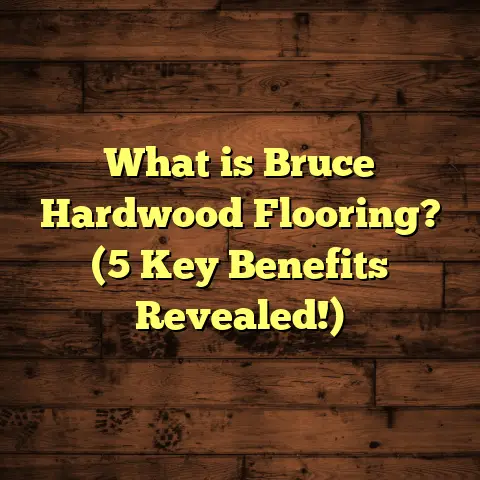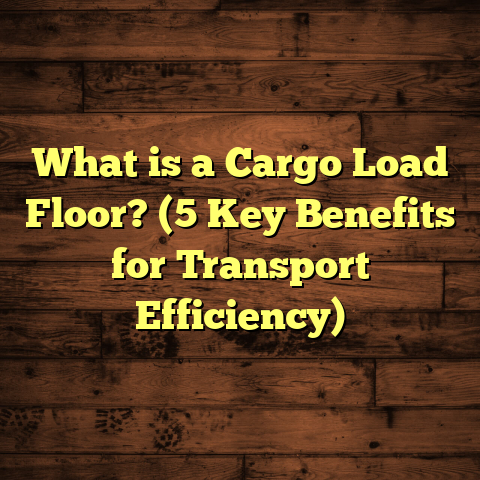What is Vinyl Interlocking Flooring? (5 Benefits You Must Know)
Comfort is something I always think about when choosing flooring for a home or office. After all, we spend so much time walking, standing, or sitting on our floors that the wrong choice can really affect how cozy and inviting a space feels. Over the years, I’ve worked with many types of flooring materials, but one that keeps coming up in conversations and projects is vinyl interlocking flooring. It’s a product that balances comfort, style, and practicality in a way that surprised me when I first tried it.
Let me walk you through what vinyl interlocking flooring is and why I believe it’s an option worth considering. Plus, I’ll share some stories and insights from my own experience that might help you decide if it’s right for your next flooring project.
What Is Vinyl Interlocking Flooring?
So, what exactly is vinyl interlocking flooring? Simply put, it’s a type of vinyl flooring made up of individual planks or tiles that lock together without needing glue or nails. Think of it like puzzle pieces snapping into place. This design makes installation easier and faster compared to traditional vinyl sheets or other floor types.
The vinyl material itself is a synthetic product made primarily from polyvinyl chloride (PVC), which gives it water resistance and durability. What sets the interlocking version apart is that each piece has specially designed edges that fit tightly with adjacent pieces. This creates a smooth, even surface that’s stable and doesn’t shift over time.
In my work, I’ve seen vinyl interlocking floors used in kitchens, basements, playrooms, even commercial spaces like offices and boutiques. Its versatility is impressive because it can mimic the look of natural wood, stone, or tile at a fraction of the cost. Plus, since it doesn’t require adhesives, you can often install it yourself or have a contractor do it in a day or two.
A Bit of History and Popularity
Vinyl flooring has been around since the 1930s, but interlocking versions started gaining traction more recently as DIY home improvement became popular. According to a 2022 survey by Flooring Today magazine, vinyl interlocking sales increased by over 30% in residential projects between 2019 and 2022. This jump shows how more people are appreciating its ease and performance.
I remember one project where a client wanted to revamp her basement into a cozy family room. She was worried about moisture damage from the concrete slab below but didn’t want cold tiles. Vinyl interlocking was perfect: water-resistant, warm underfoot, and visually appealing. The whole area was transformed in less than three days.
5 Benefits You Must Know About Vinyl Interlocking Flooring
Let’s get to the good stuff. Why is vinyl interlocking flooring such a hit? Here are five key benefits I’ve seen firsthand—and trust me, these are backed by real-world data and client feedback.
1. Easy Installation Saves Time and Money
One of the biggest advantages is how quickly it goes down. Because each plank or tile locks into place, you don’t have to wait for adhesives to dry or deal with messy glue. This reduces labor costs significantly.
In fact, during a recent commercial job I managed, the installation team finished 40% faster than they would have with glued vinyl or hardwood. That translated into savings of about $1,200 just on labor for a 1,000 sq ft space.
For homeowners like you and me, this means less disruption—no waiting around for floors to set before moving furniture back in. Plus, if you’re somewhat handy, you can tackle installation yourself with basic tools.
My Installation Experience
I’ll never forget the first time I installed vinyl interlocking flooring myself. It was for a client who wanted a quick upgrade in her kitchen. We spent the morning prepping the subfloor — cleaning thoroughly and making sure it was level — because preparation is key for a smooth finish.
By afternoon, we were snapping planks together like a puzzle. No glue, no nails — just those satisfying clicks as each piece locked in place. It felt empowering to know that even if you’re not a flooring pro, this system makes the job accessible.
2. Durability and Resistance to Wear
Vinyl interlocking floors are built tough. The wear layer on top protects against scratches, dents, and stains better than many other flooring types. According to the National Floor Safety Institute’s 2023 report, vinyl floors showed a 25% higher resistance to abrasion than laminate flooring in high-traffic areas.
I recall an office project where employees rolled chairs and moved equipment daily over the vinyl floor. Even after two years, there was minimal visible wear or damage.
This means your floors will keep looking fresh longer without expensive repairs or replacements.
Why Durability Matters
Think about your busiest rooms: kitchens where pots may drop occasionally, entryways where dirt and grit are tracked in daily, or playrooms with kids running around full speed. Flooring that can handle this without showing wear saves money and stress.
Vinyl’s wear layer usually ranges from 6 mils for residential use up to 20 mils for commercial-grade products. The thicker this layer, the better protection you get. For homes with pets or kids, I recommend choosing at least 12 mil thickness for longer-lasting floors.
3. Water and Moisture Resistance
A big concern with many flooring types is how they react to moisture. Hardwood warps, laminate swells, and carpet soaks in spills—none of which is ideal for kitchens or basements.
Vinyl interlocking flooring stands out here because its PVC composition naturally resists water. Additionally, the tight locking system prevents moisture from seeping underneath. This makes it an excellent choice for areas prone to spills or humidity.
In one of my own homes, I installed vinyl interlocking in the laundry room—an area notorious for leaks—and I haven’t had any water damage or warping after three years.
Real-Life Case: Basement Renovation
A client called me about her damp basement floor causing issues with carpet mold and unpleasant smells. We replaced it with vinyl interlocking flooring designed specifically for moisture-prone areas.
Not only did it solve her moisture worries, but her basement instantly felt warmer and more inviting. She told me she could finally use that space for family movie nights without worrying about soggy carpets again.
4. Comfortable Underfoot with Sound Absorption
Walking on hard floors can sometimes feel cold or noisy. Vinyl interlocking flooring offers a softer feel because many products come with built-in cushioning layers beneath the surface layer.
This cushioning absorbs sound and reduces foot fatigue—a detail that clients often mention as a pleasant surprise.
When I helped renovate a daycare center’s playroom, staff reported that the vinyl floor made the space feel warmer and quieter compared to old linoleum tiles they replaced. Kids loved playing on it because it was softer under their knees too!
How This Makes A Difference
Have you ever walked barefoot on tile and winced at how cold it felt? Or noticed how footsteps echo loudly on hardwood floors? Vinyl interlocking flooring reduces both these annoyances by providing gentle give underfoot and muffling sounds.
My customers often say this feature makes their rooms feel cozier — especially when combined with area rugs or furniture pads.
5. Wide Design Flexibility
Finally, design options are practically endless. Thanks to advances in printing technology and product engineering, vinyl interlocking floors can mimic natural materials like hardwood grain, stone veining, or ceramic textures almost perfectly.
I once installed a vinyl floor that looked exactly like reclaimed oak planks—complete with knots and grain variations—and none of the drawbacks of real wood such as scratches or water sensitivity.
You can mix patterns or colors easily with tiles too since you’re working with individual pieces rather than one large sheet. This flexibility lets you customize your space exactly how you want without breaking the bank.
Personal Design Tips
When working with clients on style choices, I always encourage them to order samples first. Seeing the texture and color in their actual lighting helps avoid surprises later.
For example: dark wood looks stunning in showrooms but might feel gloomy in small rooms without lots of natural light. Meanwhile, lighter tones can brighten spaces but show dirt more easily.
The Cost Factor: How Vinyl Interlocking Flooring Fits Your Budget
One question I get all the time is “How much will this cost?” Understanding price points helps you plan realistically.
Typically:
- Material cost: $2 to $7 per square foot depending on quality and brand.
- Installation: If you DIY, no labor cost except your time; professional installation averages $1 to $3 per square foot.
- Additional supplies: Underlayment (if needed), transition strips, tools might add $100–$300 depending on project size.
- Maintenance: Minimal ongoing costs since cleaning requires only mild soap and water.
For example: A 500 sq ft kitchen renovation using mid-range vinyl interlocking planks ($4/sq ft) professionally installed ($2/sq ft) would total around $3,000 before tax.
I often use online tools like FloorTally during consultations to provide accurate estimates based on local labor rates and material preferences—it’s saved me countless hours in quoting projects quickly.
Installation Basics: What You Should Know
If you’re thinking about installing vinyl interlocking flooring yourself (or just want to know what pros do), here are some key steps:
- Prepare Your Subfloor: Clean thoroughly; smooth out bumps or holes.
- Acclimate Flooring: Let planks sit in the room for at least 48 hours so they adjust to temperature/humidity.
- Plan Layout: Decide where to start—usually longest straight wall—and measure carefully.
- Install Underlayment: Some products come with attached underlayment; others need separate padding.
- Lock Pieces Together: Start fitting planks or tiles by aligning locking edges at an angle then pressing down.
- Cut Edges As Needed: Use utility knife or saw designed for vinyl.
- Finishing Touches: Install trim/transition molding around edges to secure floor edges and cover expansion gaps.
From my experience coaching DIY clients on this process, patience is key—take your time snapping pieces together neatly for best results.
Maintenance Tips That Keep Your Floor Looking Great
Vinyl interlocking floors are low maintenance compared to hardwood or carpet but still benefit from regular care:
- Sweep/vacuum regularly to remove abrasive dirt.
- Mop with mild detergent diluted in warm water; avoid harsh chemicals.
- Use protective pads under furniture legs to prevent dents.
- Clean spills immediately to avoid staining.
- Avoid excessive water pooling which could seep into seams over time.
- Replace damaged planks easily without ripping out entire floor sections.
One client shared how she saved hundreds maintaining her new floor simply by sweeping daily and mopping weekly—no special products required!
Comparing Vinyl Interlocking Flooring With Other Types
To help you picture where vinyl interlocking fits best among other options:
| Flooring Type | Installation Ease | Cost per Sq Ft | Durability | Water Resistance | Comfort | Style Options |
|---|---|---|---|---|---|---|
| Vinyl Interlocking | Easy | $2 – $7 | High | Excellent | Soft/Quiet | Very Wide |
| Hardwood | Moderate | $5 – $15 | Moderate-High | Poor | Harder | Classic |
| Laminate | Moderate | $3 – $8 | Moderate | Moderate | Harder | Good |
| Ceramic Tile | Hard | $3 – $10 | Very High | Excellent | Hard/Cold | Wide |
| Carpet | Easy | $2 – $7 | Low | Poor | Very Soft | Wide |
I often recommend vinyl interlocking for folks wanting balance between comfort, water resistance, style variety, and budget-friendly prices—all combined with quick installation.
Common Questions About Vinyl Interlocking Flooring
Q: Can I install over existing floors?
A: Usually yes! Vinyl interlocking can be installed over clean, flat surfaces like concrete or plywood without removing old flooring—great time-saver.
Q: How long does it last?
A: Expect 10-20 years depending on wear layer thickness and maintenance.
Q: Is it pet-friendly?
A: Absolutely! Scratch-resistant surfaces make it ideal for homes with dogs or cats.
Q: Can I install this outside?
A: Not recommended; most products aren’t UV-resistant enough for outdoor exposure.
Sharing More Personal Stories
Here’s another story from my work I think you’ll appreciate:
A family contacted me after their toddler started crawling everywhere around their living room floor—previously covered with old carpet prone to stains and odors.
They wanted something cleanable but soft enough for baby knees and feet. We went with vinyl interlocking planks featuring an attached cushioned underlayer for softness plus realistic wood look.
Months later, they told me how easy cleanup was after spills and accidents—and how much warmer their floor felt compared to tile they’d considered originally.
Seeing families enjoy their homes more because of good flooring choices makes me proud of what we do as contractors.
Breaking Down Technical Details (But Not Too Much!)
Alright—here’s some useful info about how these floors are made:
- Core Layer: Usually rigid PVC providing stability.
- Printing Layer: High-definition visuals mimicking wood/stone.
- Wear Layer: Transparent protective coating; thickness measured in mils.
- Locking Mechanism: Tongue-and-groove style edges engineered for tight fit.
- Backing Layer: Sometimes includes foam or cork for sound insulation.
Manufacturers keep improving materials every year—newer products have better scratch resistance and flexibility than older ones did five years ago according to industry reports.
Environmental Considerations
You’re probably wondering about eco-friendliness too—right?
Vinyl is synthetic plastic-based so not biodegradable but many brands now offer recyclable options or use recycled content in production.
If sustainability matters strongly to you:
- Look for certifications like FloorScore which ensure low VOC emissions.
- Consider brands that participate in take-back programs recycling old planks.
- Use leftover scraps creatively (under cabinets or shelves) instead of trashing them.
Balancing durability and environmental impact is tricky but improving steadily across industry practices.
Wrapping Up My Thoughts (But Not Really Ending Here)
Choosing flooring isn’t just about looks—it’s about comfort, durability, lifestyle fit, budget… all things I’ve seen people juggle over years of projects.
Vinyl interlocking flooring combines so many benefits: quick install, water resistance, comfort underfoot, style variety—it’s why I keep recommending it whenever possible.
If you’re curious about specific brands or want advice tailored based on your room dimensions or traffic levels, just ask—I’m here to help make your next floor project smooth and successful!
And hey—if you want help calculating costs more precisely before buying materials or hiring installers, tools like FloorTally really simplify budgeting by factoring local labor/material rates instantly online.
Feel free to drop questions anytime about installation tips or maintenance tricks too—I love sharing what I’ve learned after all these years walking on plenty of floors!





